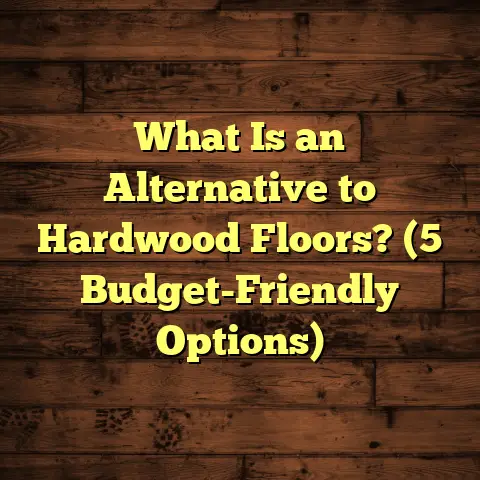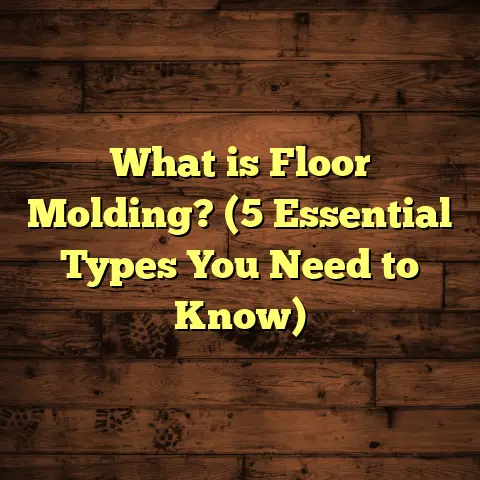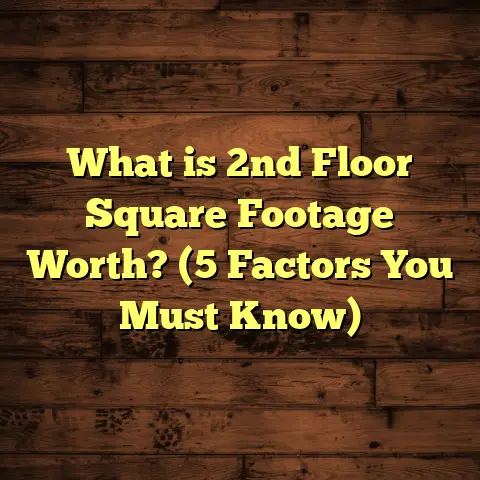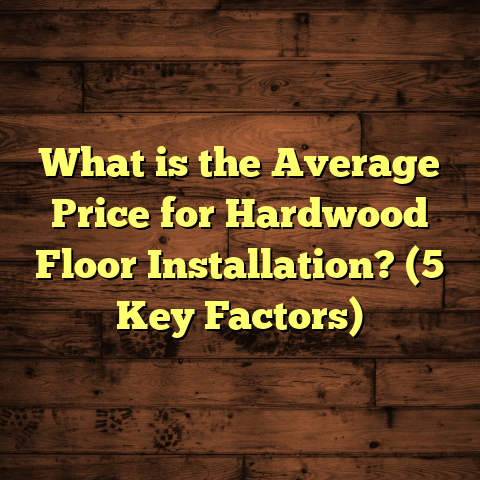What Is Vinyl Sheet Flooring? (5 Benefits for Your Home)
Have you ever paused to think about how the floor beneath your feet shapes your daily life? How it affects the feel of your home, the comfort you enjoy, and even the way you clean up after a busy day? Flooring isn’t just something you walk on; it’s a part of your living experience. So when I started exploring options for my own home, I wanted a flooring type that was not only beautiful but also practical and long-lasting. That’s when I got to know vinyl sheet flooring—and let me tell you, it’s been quite the discovery.
What Is Vinyl Sheet Flooring?
Let me explain what vinyl sheet flooring really is because sometimes the name alone can cause confusion.
Vinyl sheet flooring is a type of resilient flooring made primarily from polyvinyl chloride (PVC), a synthetic plastic polymer. Unlike vinyl tiles or planks that come as individual pieces, vinyl sheet flooring arrives in large rolls—usually between 6 and 12 feet wide. These big sheets cover a large area with very few seams, making them ideal for spaces where you want moisture resistance and uniformity.
Each sheet consists of multiple layers:
- Backing Layer: This is usually made from felt or fiberglass which provides structural support.
- Core Layer: The thickest part, often a vinyl composite, gives durability and flexibility.
- Design Layer: Printed graphics that mimic wood grain, stone, ceramic, or abstract patterns.
- Wear Layer: A transparent protective coating that shields the design from scratches, stains, and dents.
What makes vinyl sheet flooring stand out is this wear layer’s thickness and quality. It determines how resistant your floor will be to daily challenges like pets’ claws, dropped utensils, or heavy furniture.
When I first started working in flooring over a decade ago, vinyl sheets were often seen as cheap alternatives with limited styles. Fast forward to now, and manufacturers have made incredible strides. Today’s sheets can look just like expensive hardwood or natural stone but cost a fraction and offer easier maintenance.
Why does this matter? Because your floor should fit your lifestyle without breaking the bank or demanding hours of upkeep.
Personal Journey: Discovering Vinyl Sheet Flooring
I’ll share a quick story from my own life that highlights why vinyl sheet flooring made sense for me.
A few years back, I remodeled my kitchen and laundry area—two rooms that see a lot of water spills and heavy foot traffic. Initially, I thought hardwood or ceramic tile would be perfect. But after some research and talking to fellow contractors, I realized the potential downsides: hardwood could warp with moisture; tile grout can stain and crack; plus both options were going to stretch my budget.
Then I stumbled upon vinyl sheet flooring at a trade show. The samples felt sturdy yet soft underfoot. The designs were stunning—some looked like real wood planks with authentic grain and knots. The reps explained how the waterproof surface would protect against spills and leaks.
I decided to go for it in my laundry room first. The installation was quicker than expected, and the seamless look made the space feel bigger. After two years of heavy use with no scratches or water damage, I put vinyl sheet in my kitchen as well.
Since then, I’ve recommended vinyl sheet floors to dozens of clients who needed affordable but attractive solutions for busy spaces. Every time, I see happy homeowners who appreciate how practical and stylish this option can be.
The Benefits of Vinyl Sheet Flooring for Your Home
Now I want to share what I’ve learned about vinyl sheet flooring’s key benefits. These aren’t just surface-level claims; they’re based on real-world data and my hands-on experience.
1. Exceptional Durability for Everyday Life
One thing I always ask clients is: “How much wear and tear will your floors face?” If you have children running around, pets scratching, or frequent gatherings, you need something tough.
Vinyl sheet flooring’s durability comes mainly from its wear layer. This layer varies in thickness:
- Residential Grade: Usually 8-12 mil (0.2–0.3 mm)
- Light Commercial Grade: 12-20 mil (0.3–0.5 mm)
- Heavy Commercial Grade: 20-30 mil (0.5–0.75 mm)
The thicker this wear layer is, the longer your floor will last without showing damage.
According to the Resilient Floor Covering Institute (RFCI), commercial-grade vinyl sheet floors can withstand up to 20 years of heavy foot traffic with minimal wear.
In one project I managed recently for a daycare center, they chose a 28 mil wear layer vinyl sheet floor. After two years with dozens of children running through daily, the floor showed almost no wear marks. This speaks volumes about its toughness.
For home use, residential-grade sheets still provide excellent protection against scratches from pets or moving furniture. Plus, some products have added UV inhibitors that help prevent fading even with sunlight exposure.
2. Water Resistance That Protects Your Floors
Water damage is one of the worst enemies of many floor types. Hardwood swells and warps; laminate absorbs moisture and peels; even tile grout can develop mold if water seeps in.
Vinyl sheet flooring offers near-complete water resistance because it’s essentially one continuous piece with minimal seams. The seams are heat-welded or glued tightly to prevent water penetration.
Here are some interesting data points:
- Vinyl flooring’s water absorption rate is less than 0.1%, compared to hardwood’s 7-12% (source: Wood Products Council).
- According to a survey by HomeAdvisor, water damage repairs average over $2,000 for hardwood floors but are almost negligible for vinyl floors due to their resistance.
- The Consumer Product Safety Commission rates vinyl floors as suitable for wet areas like bathrooms and kitchens because of their waterproof properties.
In my own laundry room experiment mentioned earlier, a small washing machine leak caused no damage at all because the water simply stayed on top until I wiped it up.
If you have a basement or bathroom that’s prone to moisture buildup, vinyl sheet flooring is one of the safest bets out there. It won’t swell or delaminate like laminate or wood might.
3. Comfort Underfoot That Makes a Difference
Have you ever stood on cold tile floors in winter? Or felt stiff after standing on concrete basement floors for hours?
Vinyl sheet flooring is softer and warmer underfoot than many alternatives because of its cushioned backing layers and flexible core.
Some manufacturers add foam or cork underlayments beneath the vinyl sheets for extra padding. This reduces fatigue when standing long periods—great if you cook a lot or work from home.
Research from the National Floor Safety Institute shows vinyl sheet floors provide better shock absorption compared to ceramic or stone tiles. This reduces strain on knees and backs when standing or walking around.
In fact, I noticed this difference myself when renovating my kitchen. The vinyl sheet floor felt springier and less tiring during long cooking sessions than the previous tile floor.
Also worth mentioning: vinyl doesn’t get as cold as stone or ceramic tiles do in winter months because it has better insulating properties with an R-value around 0.1 – 0.15 (compared to near zero for tile).
4. Style Options That Fit Any Design Taste
I can’t tell you how many times people assume vinyl flooring looks cheap or boring—that’s just outdated thinking.
Today’s vinyl sheet floors come in an astonishing variety of styles and textures:
- Realistic wood grains that imitate oak, maple, hickory, and more
- Natural stone looks like granite, slate, marble
- Ceramic tile patterns with grout lines printed right on
- Abstract patterns and bold colors for modern interiors
With advanced printing technology and embossing techniques, these floors replicate natural materials so well it’s hard to tell the difference unless you get down close.
A recent industry report by Floor Covering Weekly showed over 60% of new residential vinyl installations were chosen for their realistic wood or stone looks—proof that style matters just as much as function.
Plus, if you want to switch designs later on, vinyl sheets are easier and less expensive to replace than hardwood or stone slabs.
5. Easy Installation Saves Time and Money
If you’re handy or working with professionals on a budget, installation speed can make a huge difference in overall project cost.
Vinyl sheet floors come in rolls that installers cut precisely to fit any room shape. This means fewer joints to align compared to tile or plank systems.
Standard installation methods include:
- Full spread adhesive: The entire subfloor is covered with glue before laying the sheet.
- Loose lay: For thicker sheets with non-slip backing.
- Peel-and-stick varieties: Self-adhesive backing for DIY projects.
Based on my experience installing vinyl sheet floors for clients and myself:
- Professional installation takes about half the time compared to tile.
- DIYers can handle smaller rooms with peel-and-stick options over a weekend.
- Clean-up is simple because there’s no grout mess like with tiles.
I once helped my sister redo her basement workshop floor using vinyl sheet. We prepped the concrete slab together over one day then installed the sheet the next afternoon—quick and painless!
Deeper Insight: Vinyl Sheet Flooring vs Other Flooring Types
To give you more context on why vinyl sheet stands out, here’s how it compares against popular alternatives:
| Feature | Vinyl Sheet Flooring | Hardwood Flooring | Ceramic Tile | Laminate Flooring |
|---|---|---|---|---|
| Water Resistance | Excellent (<0.1% absorption) | Poor (7-12% absorption) | Excellent | Moderate (swells if wet) |
| Durability (wear layer) | High (up to 30 mil wear layer) | Moderate (scratches easily) | Very high | Moderate (surface can peel) |
| Installation Time | Fast (few seams) | Slow (individual planks) | Slow (grout needed) | Moderate |
| Comfort Underfoot | Cushioned & warm | Hard & cold | Hard & cold | Harder than vinyl |
| Style Variety | Wide range including wood & stone | Natural wood only | Natural stone & ceramic | Wood & stone appearance |
| Maintenance | Low (simple cleaning) | Medium (requires refinishing) | Medium (grout cleaning) | Medium (susceptible to damage) |
| Cost per Sq Ft | $2 – $5 | $6 – $12 | $5 – $10 | $2 – $5 |
Looking at this table helps me explain why so many homeowners choose vinyl sheet floors—especially where water resistance and ease are priorities.
Real Case Studies from My Work
Let me share some examples from clients I worked with over recent years:
Case Study #1: Family Kitchen Renovation
The Martins had an older kitchen with cracked tile floors that were cold and uncomfortable in winter. They wanted a warm look similar to hardwood but couldn’t afford full hardwood installation plus worried about water near the sink.
We selected a mid-range vinyl sheet product with embossed oak grain pattern and a 20 mil wear layer for durability. The large sheets created almost seamless coverage including tricky corners around cabinets.
Result: They loved how warm the floor felt underfoot and appreciated quick installation that didn’t disrupt their schedule much. After two years they reported zero scratches despite having two young children and a dog.
Case Study #2: Basement Recreation Room
The Johnson family wanted to finish their basement into a playroom but were concerned about moisture seeping through concrete slab floors.
We used commercial-grade waterproof vinyl sheet flooring with welded seams for added protection. The design mimicked natural slate tiles but without grout lines prone to mold buildup.
Result: Their basement stayed dry during heavy rains without any floor damage. Kids enjoyed the comfortable padded feel while playing games on the floor.
Maintenance Tips That Keep Vinyl Sheet Floors Looking Fresh
One of the reasons I recommend vinyl sheet flooring is how simple it is to maintain:
- Sweep or vacuum regularly to remove dirt and grit.
- Wipe spills quickly with a damp mop or cloth.
- Avoid abrasive cleaners; use pH-neutral vinyl floor cleaners.
- Place protective pads under furniture legs.
- Use rugs in high traffic areas during winter snow season to trap grit.
If maintained properly, these floors can look new for years without needing refinishing or replacement.
Addressing Common Concerns About Vinyl Sheet Flooring
I want to be upfront about some questions people often ask:
Q: Will vinyl sheet flooring feel cheap?
A: Not at all! Modern sheets have texture that feels natural underfoot—especially those with embossed surfaces mimicking wood grain or stone texture.
Q: Does it off-gas chemicals?
A: Early versions did have strong odors due to PVC content but today’s products meet strict indoor air quality standards like FloorScore certification ensuring low VOC emissions.
Q: Can I install vinyl sheets myself?
A: Yes! Many DIYers handle smaller rooms using peel-and-stick products or full spread adhesive if they’re comfortable prepping subfloors properly.
Final Thoughts from My Experience
Choosing flooring is a big decision because it affects your home’s look and how you live day-to-day. Vinyl sheet flooring offers an incredible combination of durability, style options, comfort, water resistance, and affordability that few other materials match.
From personal projects to client homes across different needs—kitchens, basements, laundry rooms—I’ve seen vinyl sheet perform beautifully year after year with minimal fuss.
If you want something practical yet stylish that fits busy lifestyles without costing a fortune or requiring constant upkeep, give vinyl sheet flooring a serious look before deciding on hardwood or tile.
So tell me—the floors in your home: are they working well for your family? What would make them better? If you’re curious about trying vinyl sheet flooring somewhere in your place, feel free to ask! I’m here to help share what I’ve learned so your floors can feel just right every day you walk across them.





